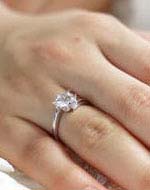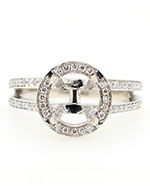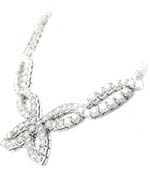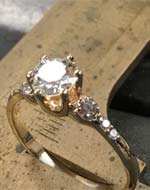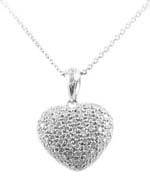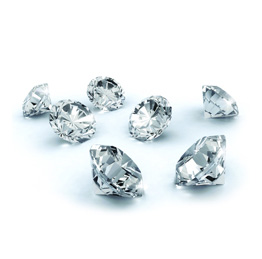- Jewelry
- Bridal
- David Yurman
- Vintage
- Vintage and Antique Rings
- Vintage and Antique Earrings
- Vintage and Antique Necklaces & Pendants
- Vintage and Antique Bracelets
- Vintage and Antique Pins
- Vintage And Antique Accessories
- Vintage and Antique Sterling Silver
- Vintage and Antique Gold Chains
- Estate Jewelry Buying & Selling Guide
- Pre-Owned Designer Handbags
- Vintage and Antique Watches
- Watches
- Designers
- Services
- Custom Work
- Special Offers
-


-
Home / Diamond Education
Diamond Education
Diamonds: What You Need to Know
Diamonds are one of the most significant purchases you’ll make in your lifetime–not just in terms of cost, but in terms of meaning, too. It’s important to take your time, do your research, and make a well informed decision. If you feel unprepared or apprehensive about buying a diamond, take a moment to read through this page. Here, we’ll explain the factors that go into a high quality diamond. We’ll touch on what makes a diamond sparkle, how you can get a bigger-looking diamond without paying for a larger carat weight, and even give you the scoop on how professional jewelers grade diamonds. We hope you'll come away with the facts you need to make a confident and educated decision.
Let's start by covering the 4 Cs: Cut, color, clarity, and carat.
- Diamond Cut
- Diamond Color
- Diamond Clarity
- Diamond Carat

Perhaps the most impactful of the 4 Cs, diamond cut describes the proportions and facets of a diamond. Proportions include the diamond’s height (also called ‘depth’), width, and table size (the table is the large, flat face on top of the diamond). Facets are the tiny planes cut symmetrically into the diamond. A well cut diamond will absorb plenty of light. The light will then bounce around the facets before being reflected back out into the world.
Diamond cutters must be extremely skilled and meticulous to create well cut diamonds. Even the smallest deviations from ideal faceting and proportions can have a major effect on the final product. Diamonds that are too deep or too shallow, too narrow or too wide, will not absorb light properly. They'll lose light either from the sides or the bottom–a process referred to as light leakage. The less light a diamond absorbs, the less light gets reflected off the facets and back into the world, resulting in a duller diamond.

Diamonds are judged based on their lack of color. Fully transparent, colorless diamonds are considered the most valuable. It’s exceedingly rare to find a diamond with no hint of color. However, most diamonds sold in jewelry stores are so faintly colored that you can’t even tell they have any tint at all. Still, it’s a good idea to familiarize yourself with diamond color grading, which is judged on an alphabetical scale.
D-F: Completely colorless. The rarest possible grades.
G-J: Nearly colorless. Diamonds with these grades are commonly used in jewelry, since the tint is essentially invisible to the naked eye.
K-M: Very faintly colored. Some light yellowish or brownish tint may be visible if the diamond is large, or if you look very closely.
N-R: Faintly colored. Some light yellowish or brownish tint is visible, especially if the diamond is large, or if you are looking closely.
S-Z: Lightly colored. A yellowish or brownish tint is obvious. Diamonds tinted beyond a grade of Z are called "fancy colored diamonds" and are no longer considered white diamonds at all.

Jewelers judge a diamond's clarity based on the presence of any flaws. Diamonds are created through natural processes. Even lab grown diamonds are created in chambers that mimic the conditions by which diamonds form within the earth. Mother Nature is not perfect, and neither are the diamonds she creates. Diamond flaws can be divided into two categories: inclusions and blemishes.
Inclusions are flaws within the structure of the diamond, such as trapped gas bubbles or small pieces of other minerals. Blemishes are flaws on the surface of the diamond, such as tiny pits or shallow scratches. Most flaws in jewelry-quality diamonds are too small to be seen with the naked eye, but jewelers still have a grading system that takes these into account.
FL: Flawless. This is an incredibly rare occurrence.
IF: Internally flawless. A diamond with no internal flaws, but some very minor blemishes (invisible to the naked eye).
VVS: A diamond with inclusions or blemishes that can barely be seen by a skilled jeweler under 10x magnification. Broken down into VVS1-VVS2, with VVS1 being less included.
VS: A diamond with inclusions or blemishes that can be seen by a skilled jeweler under 10x magnification. Broken down into VS1-VS2, with VS1 being less included.
SI: A diamond with inclusions or blemishes obvious to a skilled jeweler under 10x magnification, and possibly visible to the naked eye. Broken down into S1-S2, with S1 being less included.
I: A diamond with inclusions or blemishes visible to the naked eye. Broken down into I1-I3, with I1 being the least included.

Carat is the measurement of a diamond’s weight. One carat is equal to 0.2 grams. It takes 5 carats to add up to 1 gram, which is about the weight of a standard paperclip. When you think about it that way, you come to understand just how light diamonds really are–and be impressed by all the beauty they can fit into such a small package!
- Diamond Shapes
- Bigger Diamonds on a Budget
There are many diamond shapes available for your engagement rings, wedding bands, and fine jewelry. The most popular diamond shape, particularly for rings, is the round diamond. However, elongated shapes like oval, emerald, marquise and pear (sometimes called teardrop) shapes are particularly trendy these days. Diamonds also come in more squared shapes, like the Asscher and princess shapes. Cushion shaped diamonds combine square bodies with rounded edges. You can learn even more about diamond shapes in our blog.
We covered how diamond cut can improve a diamond’s sparkle, but did you know that increased sparkle can make a diamond look bigger? That scattered brilliance has a unique visual effect, convincing the eye that the diamond is larger than its actual size. If you don’t have room in your budget to up the carat weight of your diamond, just look for a diamond with a high quality cut, and you’ll get a similar result.
The shape of a diamond can also impact its perceived size. Elongated diamond shapes, like ovals, marquises, and emeralds, have a larger surface area than other diamond shapes of the same carat weight. This gives the illusion that they are bigger than their actual carat size. These diamonds, called “fancy shaped diamonds,” are also typically less expensive than round diamonds (which are the most popular diamond shape). By choosing an elongated shape, you can increase your diamond’s perceived size for a relatively lower price.
Use this space to save the products you like. To add a product here, simply click the icon.

